Introduction
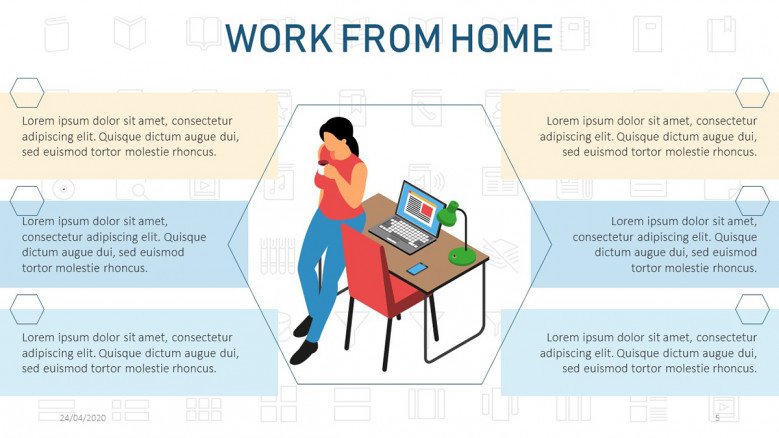
The concept of working from home has become increasingly popular in recent years, with advancements in technology and changing work culture making remote work a viable option for many professionals. The benefits of working from home are numerous and appealing. It offers flexibility in terms of working hours and location, allowing individuals to create a conducive work environment tailored to their needs. It eliminates the need for lengthy commutes, saving both time and money. Additionally, working from home provides an opportunity to achieve a better work-life balance, allowing individuals to spend more time with their families and pursue personal interests.
However, it is not without its challenges. Working from home requires discipline and the ability to manage distractions effectively. It can also lead to feelings of isolation and difficulty in collaborating with colleagues. In this guide, we will explore the strategies and tools needed to successfully work from home. From setting up an efficient home office to maintaining work-life balance and maximizing productivity, we will discuss practical tips that will help you navigate the unique challenges of remote work.
Benefits of working from home

Working from home has become increasingly popular in recent years, and for good reason. There are numerous benefits to ditching the traditional office setting and embracing remote work.
One of the key advantages is the flexibility it offers. By working from home, individuals have the ability to set their own schedules, allowing for a better work-life balance. This means they can eliminate long commutes and spend more time with family or pursuing personal interests.
Additionally, remote work often leads to increased productivity. Without distractions from colleagues or office politics, employees can focus on their tasks and complete them more efficiently. Furthermore, working from home eliminates time spent commuting, providing extra hours to dedicate to work.
Another benefit is the cost savings that come with working remotely. Employees can save money on transportation and parking expenses, as well as dining out for lunch. Additionally, there may be opportunities to negotiate lower living costs or take advantage of tax deductions related to a home office setup.
Overall, the benefits of working from home extend beyond convenience and comfort. It allows for increased flexibility, improved productivity, and potential financial savings that make it an appealing option for many professionals.
Challenges of working from home

Working from home offers numerous benefits, but it also presents its fair share of challenges. One of the main challenges is the potential for distractions. Without the structure and separation that a traditional office provides, it can be difficult to stay focused on work. Common distractions include household chores, family members or roommates, and the temptation to check personal devices or engage in non-work-related activities.
Another challenge is the lack of face-to-face interaction with colleagues. Remote workers may feel isolated and disconnected from their team members, which can negatively impact collaboration and communication. Additionally, without physical presence in an office setting, remote workers may face challenges in building and maintaining strong professional relationships.
Furthermore, working from home requires a high level of self-discipline and self-motivation. Without a supervisor or manager physically present to monitor progress, it can be easy to procrastinate or lose productivity.
Lastly, finding a healthy work-life balance can be challenging when your work space is within your living space. The lines between work and personal life can become blurred, leading to feelings of stress and burnout.
Despite these challenges, with proper strategies and tools in place, the benefits of working from home can far outweigh the drawbacks. By addressing these challenges head-on, remote workers can create a productive and fulfilling work environment within their home.
Setting Up Your Home Office
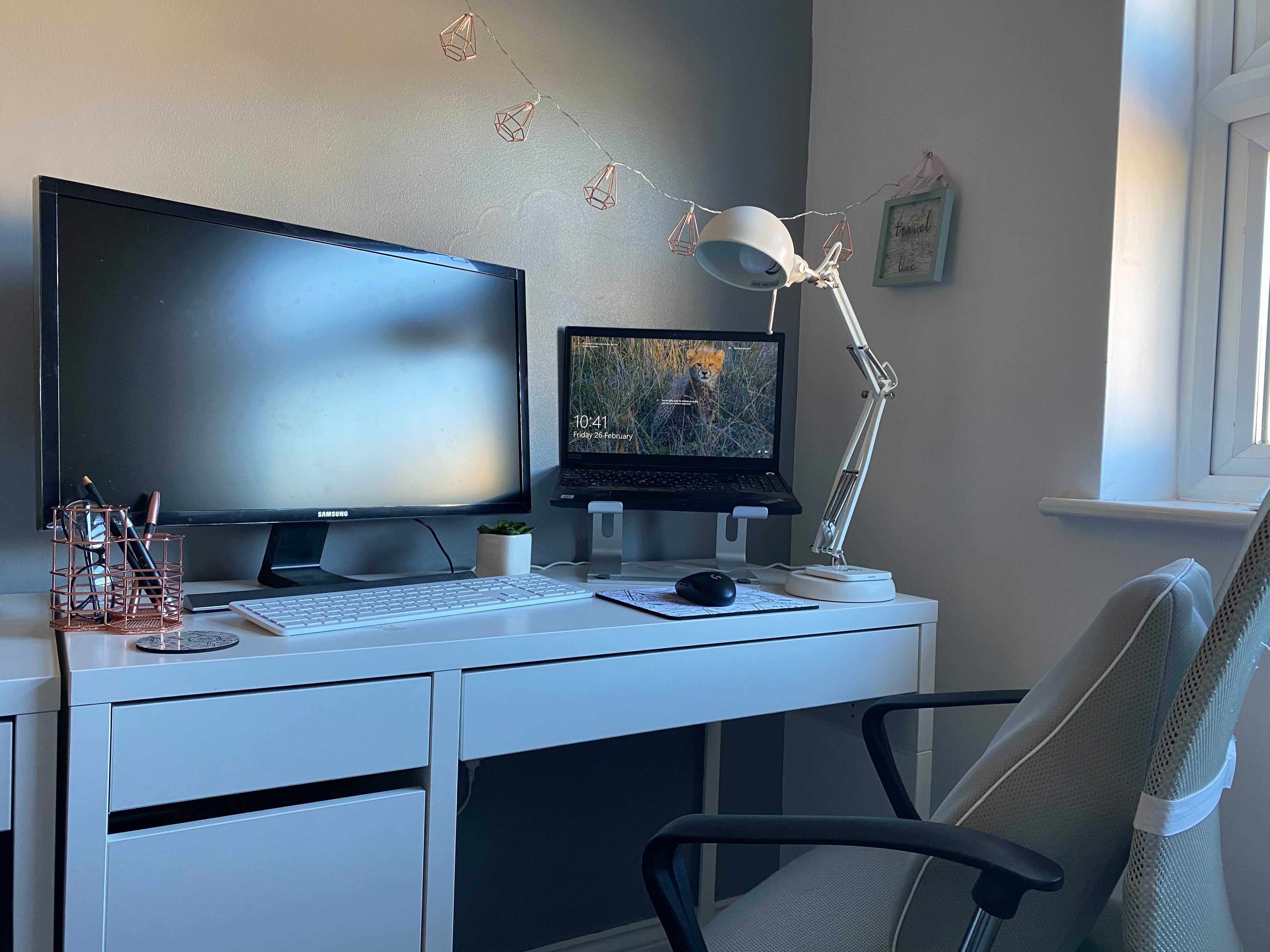
Setting up a dedicated and functional home office is crucial for ensuring productivity and focus while working from home. When choosing the right space for your home office, consider a quiet area away from distractions, such as the living room or bedroom. Ideally, it should have sufficient natural lighting and ventilation to create a conducive work environment.
Once you've identified the ideal space, it's essential to equip your home office with the necessary equipment and furniture. Invest in a comfortable, ergonomic chair and a suitable desk that provides ample workspace. Additionally, ensure you have a reliable internet connection and essential tech devices like a laptop or computer, printer, phone, and any other tools specific to your work.
To keep your workspace organized, consider investing in storage solutions like shelving units or filing cabinets. This will help maintain order and maximize efficiency in your home office.
Creating a professional setting at home is key to separating work from personal life. By setting up a designated space with all the necessary equipment and keeping it organized, you can establish an environment that promotes productivity and allows you to get into the right mindset for work.
Choosing the right space for your home office
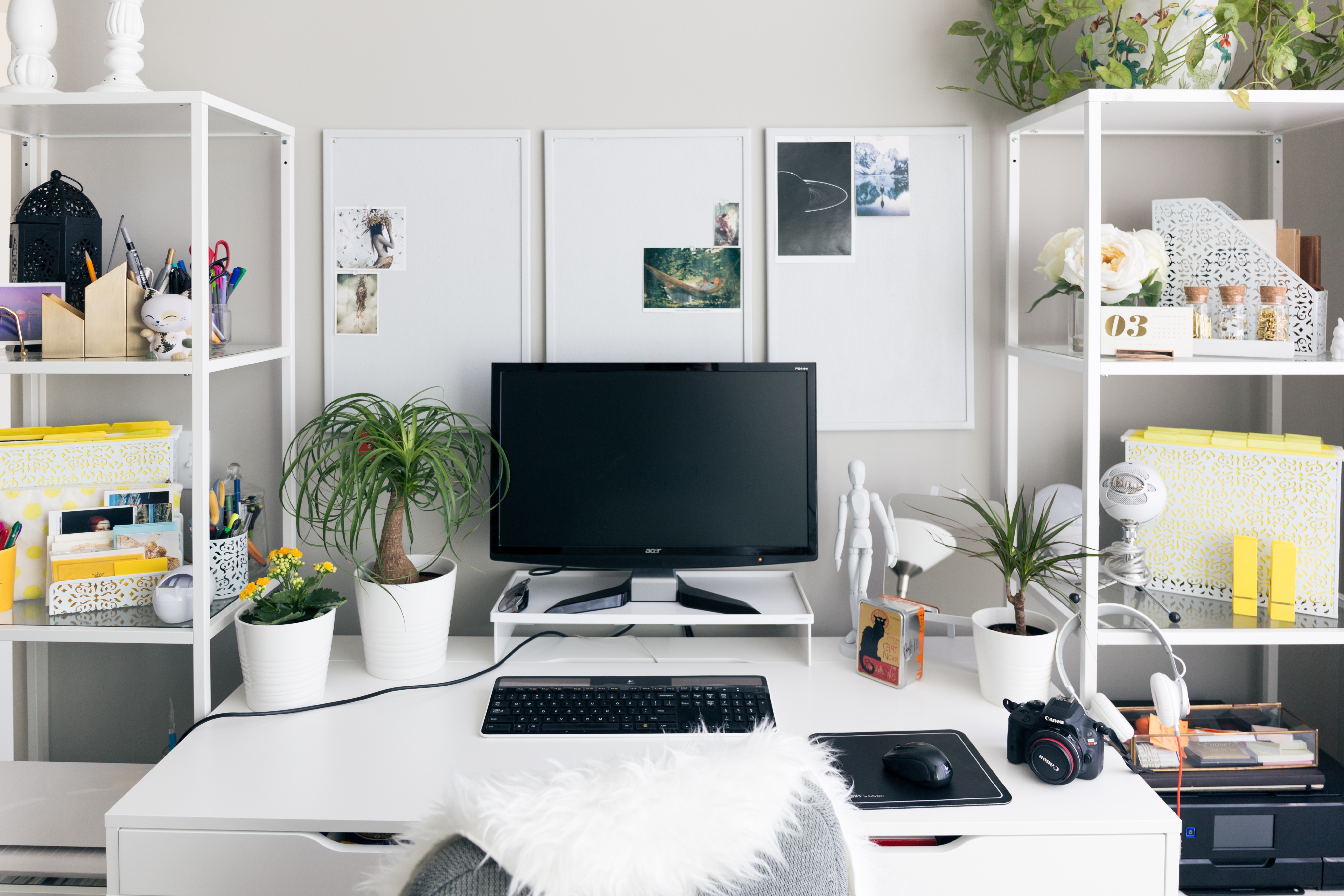
When setting up a home office, choosing the right space is crucial for creating a productive and comfortable work environment. Ideally, you should select a space that is separate from distractions and allows you to focus on your tasks.
Consider finding a room or area in your home where you can set up your office. This could be a spare bedroom, a dedicated corner in the living room, or even a converted garage or basement. It's important to choose a space with ample natural light and good ventilation to create a comfortable working atmosphere.
Additionally, consider the proximity of your workspace to the rest of your living areas. If possible, try to choose a space that is away from high-traffic areas or noisy surroundings. This will help minimize distractions and allow you to concentrate better on your work.
Furthermore, ensure that the space has sufficient storage for organizing important documents and supplies. Invest in shelves, cabinets, or storage boxes to keep everything in order and easily accessible.
Overall, selecting the right space for your home office plays a significant role in promoting productivity and focus during remote work hours.
Essential equipment and furniture for your home office

To set up a functional and productive home office, it is essential to have the right equipment and furniture. Firstly, a reliable computer or laptop with a fast and stable internet connection is crucial for seamless communication and efficient work. Investing in a comfortable chair with proper back support is essential to avoid discomfort and promote good posture during long work hours. A sturdy desk with enough surface area to accommodate your computer, documents, and other necessary tools is also necessary. Additionally, a printer/scanner, headphones or earphones for virtual meetings, and a good quality webcam are useful equipment to have. Proper lighting in your workspace is important for reducing eye strain, so consider getting a desk lamp or positioning your desk near natural light sources. Finally, organization tools such as file cabinets, shelves, and desk organizers will help you keep your workspace tidy and organized. By ensuring you have the right equipment and furniture in your home office, you can create an environment that promotes productivity and efficiency.
Establishing a Productive Routine

To optimize productivity while working from home, it is essential to establish a productive routine. By creating a structured schedule and sticking to it, individuals can effectively manage their time and accomplish their tasks efficiently.
One of the first steps in establishing a productive routine is to create a schedule that aligns with one's natural energy levels and peak productivity times. Some people may be more productive in the morning, while others may find their focus increases in the afternoon or evening. Tailoring the schedule to match these preferences can maximize productivity.
Another crucial aspect of maintaining a productive routine is managing distractions at home. These distractions can include household chores, social media notifications, or personal obligations. It is important to set boundaries by creating designated work hours and informing friends and family about these times. Additionally, using techniques such as time-blocking and using productivity apps can help reduce distractions and stay on track.
By establishing a productive routine, individuals can enhance their focus, avoid procrastination, and accomplish their work efficiently while working from home.
Creating a schedule and sticking to it

Creating a schedule and sticking to it is crucial for maintaining productivity while working from home. When you have a structured plan in place, it helps you stay focused and ensures that you allocate time for all your tasks and responsibilities.
To create an effective schedule, start by determining your most productive hours of the day. This can vary from person to person, so pay attention to when you feel most energized and focused. Block out these peak periods for your most important and challenging tasks.
Next, prioritize your tasks and allocate specific time blocks for each one. Break down larger projects into smaller, manageable steps, and assign deadlines to keep yourself on track. Consider using time management techniques such as the Pomodoro Technique, where you work in focused bursts with short breaks in between.
Once you have created your schedule, make it a habit to stick to it. Treat your schedule as if it were a meeting or appointment that cannot be missed. Avoid the temptation to deviate from your planned activities unless absolutely necessary.
Remember, creating a schedule is only the first step; the key is to follow through consistently. By doing so, you will maximize your productivity and ensure that important tasks are completed on time.
Tips for managing distractions at home

When working from home, it's easy to get distracted by household chores, family members, or the lure of the TV. However, with a little planning and self-discipline, you can minimize these distractions and stay focused on your work.
One tip for managing distractions is to create a designated workspace that is separate from the rest of your home. This helps to mentally separate your work life from your personal life and make it easier to concentrate. Additionally, setting boundaries with family members or roommates is crucial. Let them know that when you're in your workspace, you should not be disturbed unless it's an emergency.
Another effective strategy is to eliminate digital distractions. Turn off notifications on your phone or computer and use website blockers to prevent access to social media or other distracting websites during work hours.
Taking scheduled breaks can also help manage distractions. By allowing yourself short breaks at set intervals, you can give in to small distractions without losing focus for too long.
Overall, managing distractions at home requires discipline and diligence. By implementing these tips, you can create a productive work environment and minimize interruptions throughout your day.
Communication and Collaboration Tools

In today's digital age, effective communication and collaboration are essential for remote work. Fortunately, there are numerous tools available that make it easier than ever to connect and collaborate with colleagues, regardless of physical distance.
For virtual meetings and video conferencing, popular tools like Zoom, Microsoft Teams, and Google Meet offer seamless communication through high-quality video and audio capabilities. These platforms also provide features such as screen sharing and chat functions to enhance collaboration during meetings.
In addition to virtual meetings, collaboration and project management tools like Trello, Asana, and Slack can streamline workflows and facilitate teamwork. These platforms enable teams to assign tasks, track progress, share documents, and communicate in real-time.
Furthermore, cloud storage solutions like Google Drive or Microsoft OneDrive allow for easy file sharing and access from anywhere.
By leveraging these communication and collaboration tools, remote workers can effectively communicate with team members, foster collaboration on projects, and bridge the gap between physical distances. These tools contribute to a cohesive work environment despite working remotely.
Best tools for virtual meetings and video conferencing
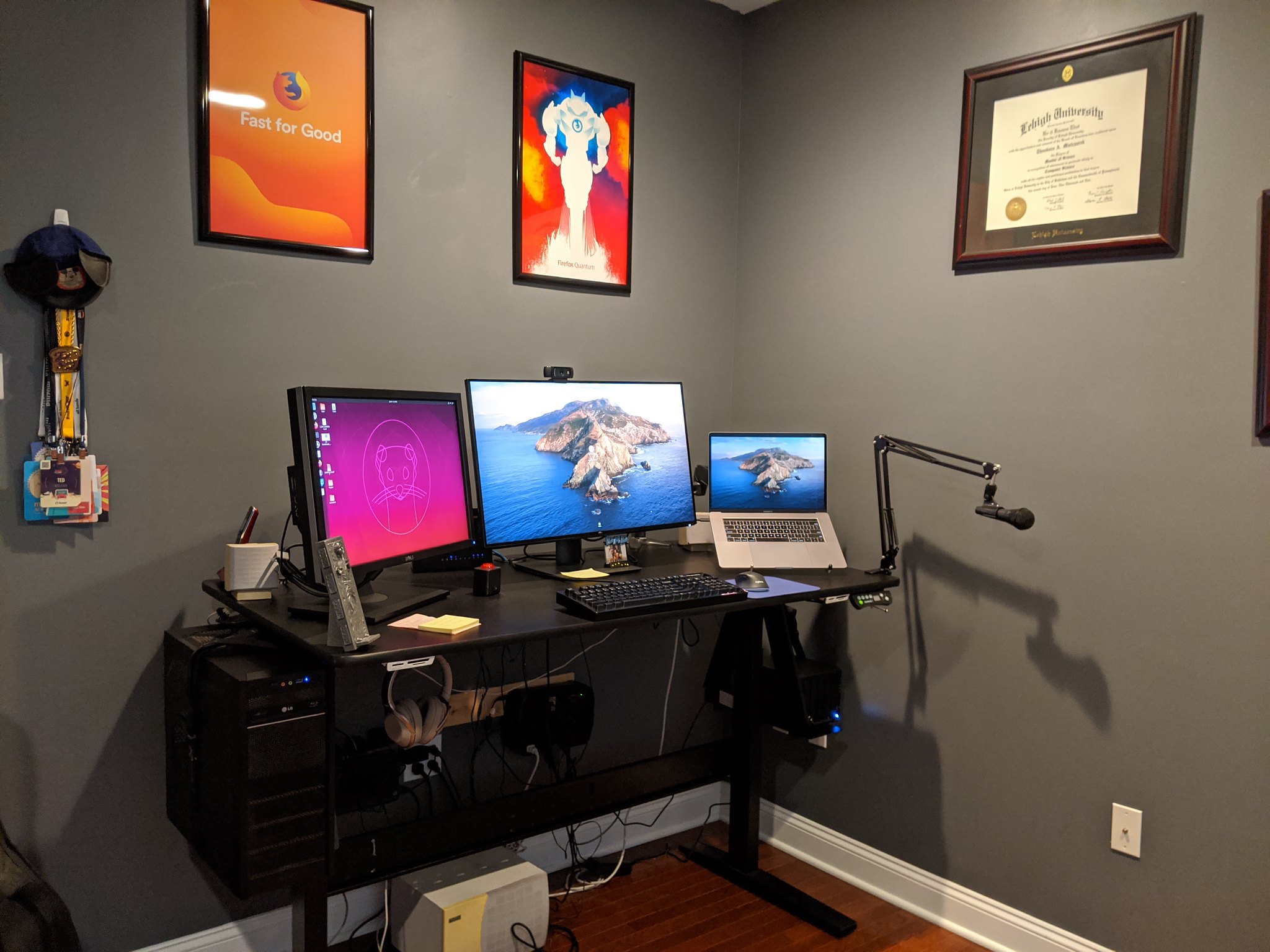
In today's digital era, virtual meetings and video conferencing have become essential for remote work. Luckily, there are several reliable tools available to facilitate seamless communication and collaboration among team members. One of the most popular options is Zoom, known for its high-quality video and audio capabilities, as well as its user-friendly interface. Microsoft Teams is another great choice, offering a wide range of features such as screen sharing and file collaboration. For those looking for a more interactive experience, Cisco Webex provides advanced features like whiteboarding and document sharing. Google Meet is also a reliable option, especially for businesses already using G Suite. Additionally, Slack offers a combination of instant messaging and video calls, making it perfect for quick collaborations. It's important to consider factors such as pricing plans, participant limits, and security when choosing the best tool for virtual meetings and video conferencing based on your specific needs.
Collaboration and project management tools

Collaboration and project management tools are essential for effectively working from home. These tools help teams stay organized, communicate seamlessly, and ensure timely completion of tasks.
One popular collaboration tool is Slack, which allows team members to create channels for different projects or topics, send direct messages, and share files. With features like notifications and integrations with other apps, Slack enhances communication and collaboration among remote teams.
For project management, tools like Trello and Asana provide a visual representation of tasks, deadlines, and progress. These platforms enable teams to track their projects, assign responsibilities to team members, set due dates, and facilitate seamless collaboration.
Another useful tool is Google Drive, which allows teams to store and share documents, spreadsheets, and presentations in the cloud. With real-time editing capabilities, multiple users can work on a document simultaneously without the need for constant back-and-forth emails.
Overall, these collaboration and project management tools streamline work processes, improve team efficiency and productivity when working remotely. By utilizing these tools effectively, remote teams can overcome challenges and successfully complete projects together.
Maintaining Work-Life Balance

Maintaining work-life balance is crucial when working from home. It can be challenging to separate personal and professional life when the line between them becomes blurred. However, with the right strategies, it is possible to create a healthy balance.
Setting boundaries between work and personal life is essential. Designate specific working hours and stick to them. Communicate these boundaries with your family or roommates so they understand when you are unavailable. Create a designated workspace where you can concentrate without distractions.
Practicing self-care is also vital for maintaining work-life balance. Take breaks throughout the day and engage in activities that recharge you, such as exercise or hobbies. Avoid overworking yourself and learn to say no when necessary.
To avoid burnout, establish clear limits on your workload and prioritize tasks effectively. Set realistic goals and deadlines, and avoid taking on too much at once. Learn to delegate tasks when possible to lighten your workload.
Remember, work-life balance is a continuous process that requires ongoing effort. By setting boundaries, practicing self-care, and managing your workload effectively, you can maintain a healthy equilibrium between work and personal life while working from home.
Setting boundaries between work and personal life

Setting clear boundaries between work and personal life is crucial for maintaining a healthy work-life balance when working from home. Without these boundaries, it can be easy to blur the lines between professional responsibilities and personal relaxation, leading to increased stress and decreased productivity.
To establish effective boundaries, it is essential to create a designated workspace in your home. This could be a separate room or a specific area in your living space dedicated solely to work-related activities. By physically separating your workspace from your personal living area, you can mentally shift into "work mode" when you enter that space and switch back to "home mode" when you exit.
Additionally, it is important to establish set working hours and stick to them as much as possible. Communicate these hours with family members or roommates so they understand when you need uninterrupted focus. Avoid working outside of these hours unless absolutely necessary to maintain a healthy work-life balance.
Furthermore, learn how to disconnect from work during personal time. Set boundaries around checking emails or attending to work-related tasks after work hours. Allow yourself time for hobbies, leisure activities, and spending quality time with loved ones.
By setting clear boundaries between work and personal life, individuals can cultivate a healthier lifestyle while working from home and avoid the pitfalls of burnout or overwhelming stress.
Practicing self-care and avoiding burnout

Practicing self-care and avoiding burnout are essential aspects of successfully working from home. When there are no clear boundaries between work and personal life, it's easy to become overwhelmed and burned out. Therefore, it is crucial to prioritize self-care to maintain your well-being and productivity.
To practice self-care while working from home, start by establishing a daily self-care routine. This can include activities such as exercise, meditation, or indulging in a hobby that brings you joy. Taking regular breaks throughout the day is also important for recharging your energy and preventing burnout.
Additionally, set clear boundaries between work and personal life. Create designated work hours and stick to them. Avoid the temptation to constantly check emails or complete work-related tasks outside of these hours. Prioritize relaxation and spending quality time with loved ones.
Furthermore, don't forget to disconnect from technology when needed. Take breaks from screens and social media platforms to give your mind a chance to rest.
By implementing these practices, you will take care of your mental and physical well-being while working from home. Remember, self-care is not selfish; it's necessary for maintaining long-term productivity and happiness in both your personal and professional life.
Maximizing Productivity

When working from home, maximizing productivity becomes essential for maintaining a consistent workflow. To achieve optimal productivity, it's crucial to stay focused and motivated. One effective tip is to establish a designated workspace that is free from distractions. Keeping a clean and organized desk can also help promote a productive mindset.
Another key factor in maximizing productivity is effective time management. Creating a prioritized to-do list and breaking tasks into manageable chunks can help stay on track and avoid procrastination. Setting clear deadlines for each task can further enhance productivity.
Additionally, taking short breaks throughout the day can actually improve focus and prevent mental fatigue. Engaging in physical activities or practicing relaxation techniques during breaks can boost energy levels and mental clarity, leading to increased productivity.
To maintain optimum productivity levels, it's important to set realistic goals and deadlines, communicate with colleagues or supervisors regularly, and seek support or guidance when needed. By implementing these strategies, individuals working from home can maximize their productivity and accomplish their tasks efficiently.
Tips for staying focused and motivated
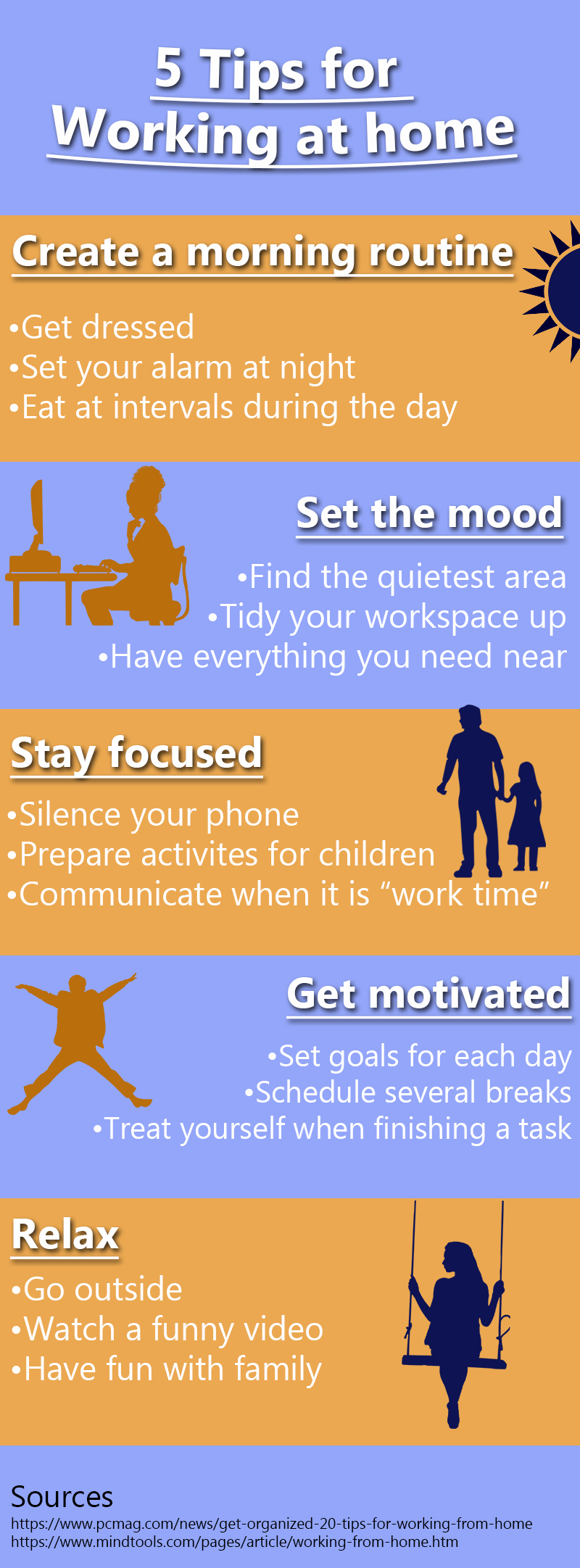
When working from home, maintaining focus and motivation can be challenging. However, with the right strategies in place, you can stay on track and accomplish your goals. Here are some tips to help you stay focused and motivated while working from home.
- Create a dedicated workspace: Designate a specific area in your home for work. This will help you separate your professional life from your personal life and minimize distractions.
- Set clear goals: Establish clear and achievable goals for each day or week. Break them down into smaller tasks to make them more manageable and celebrate your accomplishments along the way.
- Eliminate distractions: Identify potential distractions in your environment and find ways to minimize them. Turn off notifications on your phone, close unnecessary browser tabs, and communicate boundaries with family members or roommates.
- Use time management techniques: Consider using techniques like the Pomodoro Technique, where you work in short bursts of focused activity followed by short breaks.
- Find sources of inspiration: Surround yourself with motivational quotes, images, or objects that inspire you. It could be a vision board, a favorite quote on your desk, or even simple affirmations that remind you of your purpose.
By implementing these tips, you can enhance your focus and motivation while working from home, leading to increased productivity and success in your remote career. Stay disciplined and reap the rewards of a focused work-from-home routine.
Effective time management techniques

Effective time management is crucial for individuals working from home to enhance productivity and meet deadlines. Here are some effective time management techniques:
- Prioritize tasks: Start your day by identifying the most important tasks and tackle them first. Use tools like a to-do list or task management apps to stay organized.
- Time blocking: Allocate specific blocks of time for different tasks or activities throughout the day. This helps focus on one task at a time and prevents distractions.
- Set deadlines: Assign realistic deadlines for each task to maintain a sense of urgency and prevent procrastination.
- Avoid multitasking: Although it may seem efficient, multitasking often leads to decreased productivity and increased errors. Instead, concentrate on one task until completion before moving on to the next.
- Take breaks: Regular breaks during work hours can actually improve productivity and help avoid burnout. Use these breaks to refresh your mind and recharge.
- Minimize distractions: Create a dedicated workspace, turn off notifications on your phone, and avoid checking social media or personal emails during work hours.
By implementing these effective time management techniques, individuals can maximize their efficiency, better manage their workload, and achieve a healthy work-life balance while working from home
Overcoming Common Challenges
Working from home offers numerous benefits, but it also comes with its fair share of challenges. Unsurprisingly, one of the most common challenges is dealing with feelings of isolation and loneliness. Without the presence of coworkers and the social interactions that come with an office environment, remote workers may find themselves feeling disconnected. To overcome this challenge, it's important for individuals to actively seek out ways to stay connected with their colleagues. This can include regular virtual meetings, informal chats through messaging platforms, or even organizing virtual social events.
Another common obstacle that arises when working from home is managing interruptions from family members or roommates. It can be difficult to maintain focus and productivity when there are constant distractions in your environment. Setting boundaries with your loved ones and establishing clear guidelines for when you need uninterrupted work time can help mitigate interruptions.
By addressing these common challenges head-on, remote workers can create a more positive and productive work-from-home experience. It's important to keep in mind that each individual may face unique obstacles, but with the right strategies and a proactive mindset, anyone can overcome these challenges and thrive in their remote work setup.
Dealing with isolation and loneliness

Working from home can often lead to feelings of isolation and loneliness. Without the physical presence of colleagues or the camaraderie of an office environment, it's easy to feel disconnected from others. However, there are strategies you can employ to combat these feelings.
Firstly, it's important to maintain regular communication with your colleagues. Schedule virtual meetings or check-ins to stay connected and engaged with your team. Utilize collaboration tools that enable real-time interaction and foster a sense of connection.
Additionally, seek out opportunities for social interaction outside of work hours. Join online communities, forums, or groups related to your field or professional interests. Participate in virtual networking events or conferences to expand your professional network and engage in discussions.
Taking breaks and incorporating social activities into your daily routine is also crucial. Use lunch breaks to connect with friends or family over a video call, engage in hobbies, or participate in online classes or workshops. This helps alleviate feelings of isolation and ensures a balanced work-life integration.
Most importantly, practice self-care and prioritize mental well-being. Engage in activities that bring you joy and provide stress relief. Set boundaries between work and personal life to maintain a healthy balance.
By implementing these strategies, you can combat feelings of isolation and loneliness while working from home, creating a more fulfilling and enjoyable remote work experience.
Managing interruptions from family or roommates

Managing interruptions from family or roommates can be one of the biggest challenges when working from home. While it is essential to establish clear boundaries with your loved ones, it's also important to communicate your work schedule and expectations effectively.
First, set aside a dedicated workspace where you can shut the door and minimize disruptions. Communicate this space as your "office" to your family or roommates, letting them know that you shouldn't be disturbed during work hours unless it's an emergency.
Additionally, establish specific times for breaks and lunch so that your family or roommates understand when you are available for social interaction. Using visual cues like a closed-door or a "do not disturb" sign can also help indicate when you need uninterrupted time.
Open communication is key. Make sure to have open conversations with your family or roommates about the importance of uninterrupted work time and how they can support you in achieving that. Encourage them to ask questions or voice concerns outside of your designated work hours so that interruptions can be minimized.
Remember, managing interruptions is a two-way street. Be respectful of others' schedules and commitments as well, ensuring a harmonious balance between work and personal life within the household.
Staying Connected with Colleagues

In the modern age of remote work, staying connected with colleagues is crucial for maintaining effective collaboration and a sense of camaraderie within a team. While physical distance may pose a challenge, there are various strategies and tools available to bridge the gap and foster communication.
One way to stay connected with colleagues is through regular virtual meetings and check-ins. Utilizing video conferencing platforms such as Zoom or Microsoft Teams allows for face-to-face interactions, promoting better engagement and understanding among team members. Additionally, instant messaging tools like Slack or Microsoft Teams' chat feature enable real-time conversations to address any questions or concerns promptly.
Building relationships and networking remotely can also be achieved through online platforms specifically designed for professional networking, such as LinkedIn. By actively engaging with colleagues' posts, participating in discussions, and sharing industry-related articles, you can maintain connections with your coworkers and expand your professional network.
Furthermore, engaging in virtual team-building activities is an effective way to foster connections within a remote team. These activities can range from virtual happy hours to online games or collaborative projects. By creating opportunities for team bonding and casual conversations, colleagues can establish deeper relationships despite the physical distance.
Overall, staying connected with colleagues requires proactive efforts in leveraging communication tools, networking platforms, and virtual team-building activities. By consciously nurturing relationships and facilitating open communication channels, remote workers can cultivate a sense of community within their teams even when working from separate locations.
Building relationships and networking remotely

Building relationships and networking remotely can be challenging, as it requires a different approach compared to traditional in-person interactions. However, with the right strategies and tools, it is still possible to develop meaningful connections with colleagues and industry professionals.
One effective way to build relationships remotely is through virtual networking events. Many organizations now offer online conferences and webinars where professionals can connect and exchange ideas. Take advantage of these opportunities to introduce yourself, engage in discussions, and follow up with potential contacts.
Additionally, social media platforms such as LinkedIn provide a valuable platform for remote networking. Join industry-specific groups and actively participate in discussions. Share relevant articles or insights to establish credibility and attract connections.
Another way to build relationships remotely is through one-on-one virtual meetings or coffee chats. Reach out to colleagues or industry experts who you admire and request a virtual meeting. Use this time to not only discuss work-related topics but also get to know them on a personal level.
Remember, building relationships remotely requires consistent effort and genuine interest in others. Be proactive, listen attentively, and find common interests. By doing so, you can create valuable professional connections even from the comfort of your home office.
Engaging in virtual team-building activities

Engaging in virtual team-building activities is an essential aspect of working from home. While physical distance may pose a challenge, it is crucial to foster a sense of unity and collaboration among team members.
There are various virtual team-building activities that can be organized to strengthen relationships and promote teamwork. One popular option is online icebreaker games or quizzes, which allow team members to get to know each other better while having fun. Virtual team-building exercises such as problem-solving challenges or brainstorming sessions can also be conducted through video conferencing platforms, encouraging active participation and collective problem-solving.
Additionally, organizing virtual team-building events like online happy hours or virtual lunches can facilitate informal conversations and create a more relaxed and social atmosphere for team members.
Moreover, companies can arrange remote workshops or training sessions to enhance the skills and knowledge of employees while providing an opportunity for interaction. Providing opportunities for collaborative projects and assigning tasks that require teamwork through online project management tools can also foster a sense of shared purpose.
By actively engaging in these virtual team-building activities, organizations can create a positive work environment, enhance communication amongst remote team members, and improve productivity levels.
Conclusion

In conclusion, working from home offers numerous benefits such as flexibility, increased productivity, and reduced commuting time. However, it also presents challenges like managing distractions and maintaining work-life balance.
To successfully work from home, it is crucial to set up a dedicated home office space that is comfortable and equipped with the necessary furniture and equipment. Creating a productive routine and utilizing communication tools can help in staying organized and connected with colleagues.
Maintaining work-life balance is essential to prevent burnout. Setting boundaries between work and personal life, practicing self-care, and managing time effectively are key strategies to achieve this balance.
Remote work is not without its challenges, such as dealing with isolation and interruptions from family or roommates. Finding ways to stay connected with colleagues through networking events or virtual team-building activities can help combat feelings of loneliness.
In conclusion, by implementing these strategies and overcoming common challenges, individuals can enhance their productivity and success while working from the comfort of their own homes. As remote work continues to grow in popularity, it is important to stay updated on future trends and advancements in technology that support remote work arrangements.
Summary of key points
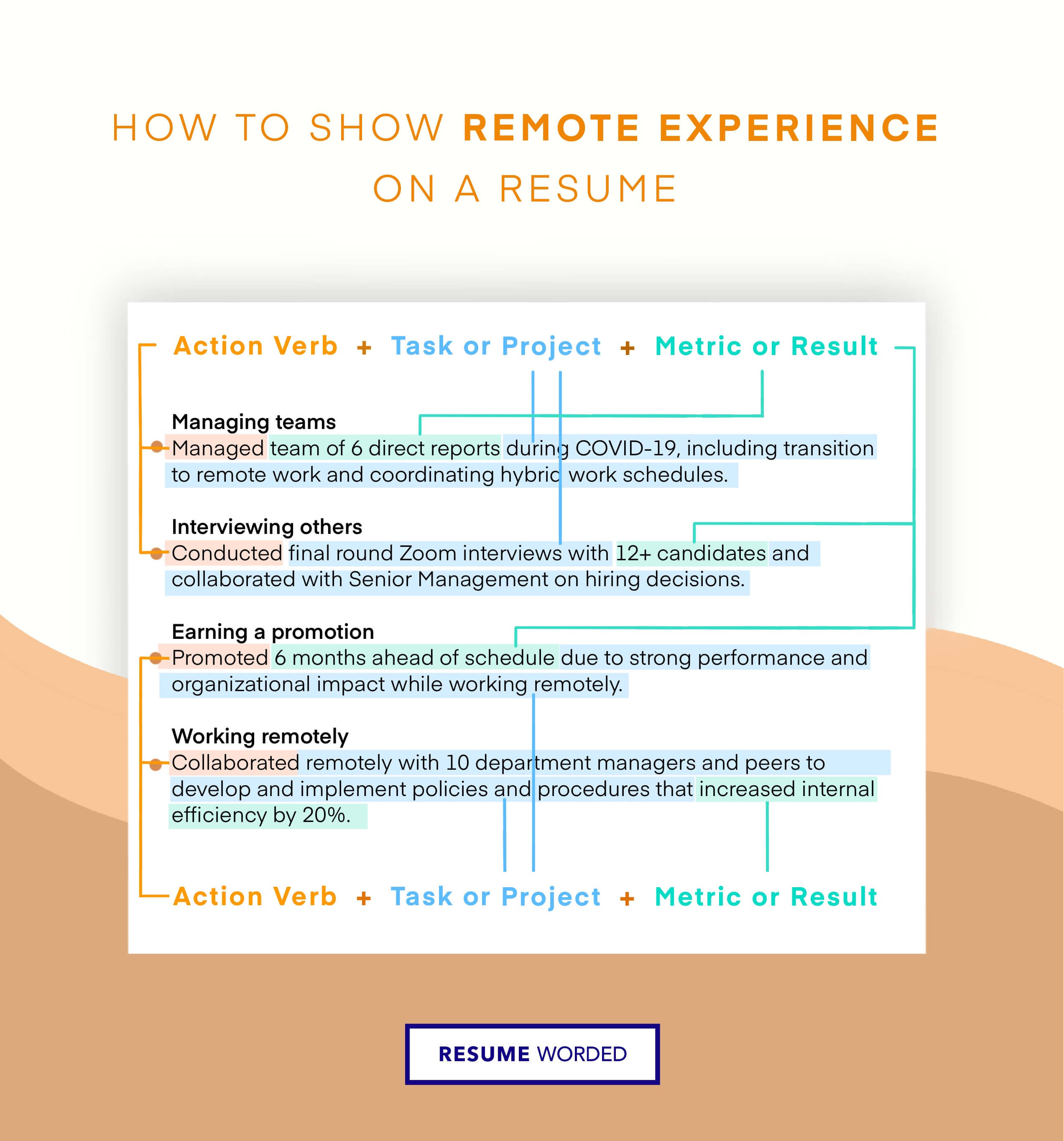
The article "How to Work From Home" has discussed various aspects of working from home and provided valuable insights into creating a productive and balanced remote work environment.
One key point emphasized is the benefits of working from home, such as increased flexibility, reduced commute time, and improved work-life balance. However, it is important to acknowledge the challenges that come with remote work, including potential distractions and feelings of isolation.
To overcome these challenges, the article suggests setting up an efficient home office space and establishing a realistic routine to stay focused and maintain productivity. Additionally, utilizing communication and collaboration tools is essential for effective virtual meetings and project management.
Maintaining work-life balance is also crucial. Setting boundaries between work and personal life, practicing self-care, and avoiding burnout are key strategies for long-term success in remote work.
The article also provides tips on maximizing productivity through staying motivated, managing time effectively, and addressing common challenges like isolation or interruptions from family or roommates.
Lastly, the importance of staying connected with colleagues through building professional relationships remotely and engaging in virtual team-building activities is highlighted.
Overall, this comprehensive guide serves as a valuable resource for individuals seeking to optimize their remote work experience.
Future trends in remote work

As the world undergoes significant changes, remote work is becoming more prevalent and is expected to continue evolving in the future. One of the key future trends in remote work is the increased adoption of advanced communication and collaboration tools. Companies are investing in technologies that facilitate seamless virtual meetings and enhance team collaboration. This includes features such as real-time document editing, project management platforms, and virtual whiteboards.
Another trend is the emphasis on work-life balance. Employers are recognizing the importance of employee well-being and are implementing policies and practices to support it. This includes offering flexible schedules, encouraging breaks, and promoting mental health initiatives.
Moreover, the concept of remote work is expanding beyond traditional office-based jobs. With advancements in technology and connectivity, we can expect to see an increase in remote opportunities across a wide range of industries.
Additionally, as companies become more globalized, remote work offers the opportunity for a diverse workforce. Businesses can tap into talent from different geographical locations without the need for relocation.
Overall, the future of remote work holds immense possibilities for both employees and employers. It allows for flexibility, increased productivity, and access to a wider talent pool. By adapting to these trends, individuals can thrive in their remote workplaces while organizations can stay competitive in an ever-changing world.
